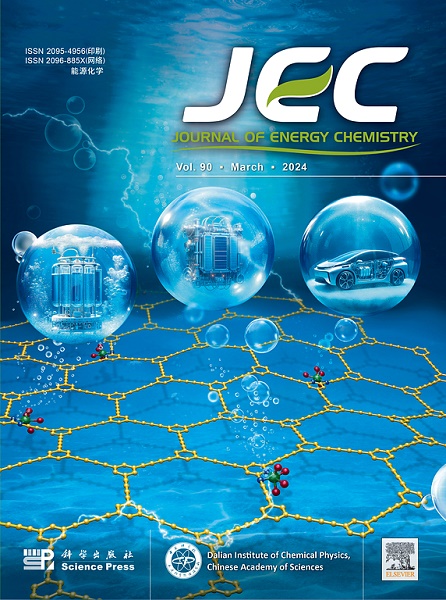Enhanced reactive oxygen species generation: Synergic process of three-electron oxygen reduction and electrochemical ozone production by bimetallic La-Nb oxides
IF 13.1
1区 化学
Q1 Energy
引用次数: 0
Abstract
The anodic electrochemical ozone production (EOP) and the cathodic three-electron oxygen reduction reaction (3e− ORR) are effective processes for generating active oxygen species (ROS). However, the activation of ozone (O3) by hydroxyl radical (·OH) to form ROS poses significant challenges. The micelle ball-like bimetallic La-Nb oxides (LNOx) have been developed as a bifunctional electrocatalyst for both the EOP and 3e− ORR reactions. The LNO20 demonstrated a 9.8% of Faradaic efficiency (FE) in O3 production and a transfer number of 2.8 electrons in the 3e− ORR. Theoretical calculations support the notion that the five-membered ring mechanism in LNO20 facilitates O3 production. Additionally, the incorporation of La provides active sites that enhance the activation of hydrogen peroxide (*H2O2) and the generation of ·OH. This innovative approach synergistically integrates EOP and 3e− ORR, enhancing the activation of O3 to produce ROS, demonstrating exceptional efficacy in the degradation of organic pollutants and antimicrobial activity. The study paves the way for designing advanced electrocatalysts for EOP and 3e− ORR and offers insights into utilizing electrochemical method to support other antibacterial strategies.

求助全文
约1分钟内获得全文
求助全文
来源期刊

Journal of Energy Chemistry
CHEMISTRY, APPLIED-CHEMISTRY, PHYSICAL
CiteScore
19.10
自引率
8.40%
发文量
3631
审稿时长
15 days
期刊介绍:
The Journal of Energy Chemistry, the official publication of Science Press and the Dalian Institute of Chemical Physics, Chinese Academy of Sciences, serves as a platform for reporting creative research and innovative applications in energy chemistry. It mainly reports on creative researches and innovative applications of chemical conversions of fossil energy, carbon dioxide, electrochemical energy and hydrogen energy, as well as the conversions of biomass and solar energy related with chemical issues to promote academic exchanges in the field of energy chemistry and to accelerate the exploration, research and development of energy science and technologies.
This journal focuses on original research papers covering various topics within energy chemistry worldwide, including:
Optimized utilization of fossil energy
Hydrogen energy
Conversion and storage of electrochemical energy
Capture, storage, and chemical conversion of carbon dioxide
Materials and nanotechnologies for energy conversion and storage
Chemistry in biomass conversion
Chemistry in the utilization of solar energy
 求助内容:
求助内容: 应助结果提醒方式:
应助结果提醒方式:


